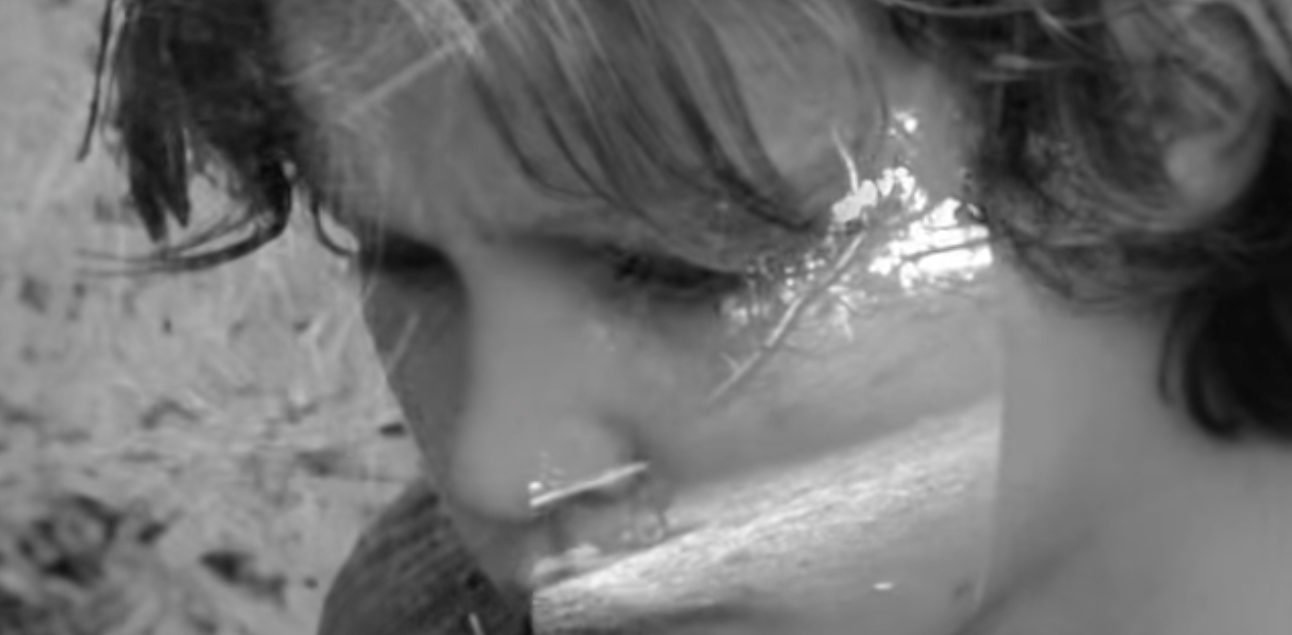Painting the Light Fantastic: Carl Brown
This review by Mike Hoolboom was originally published in the Millennium Film Journal issue no. 27 “Displacements” in 1994.
Carl Brown is part of an invisible cinema. Despite having produced three feature length films and a score of shorts he remains one of the most relentlessly obscure talents in a pursuit haunted by marginality. An avowed modernist, Brown’s aggressive assertion of film’s material base, propensity for abstraction and decision to work in a feature length format has made him an anomaly amongst Canadian film artists. He has paid little heed to the distribution of his films, choosing to work instead in the solitary of his basement. There, he has concocted a strange array of chemical brews which transport a simply representational perspective into a seething microverse of explosive colors and unknown shapes. Decrying purist notions of a sublime abstraction, Brown claims a documentary base for his efforts, insisting that they are faithful records of an upset mind-in-motion, glimpsed from the inside-out.

Brown’s first feature Full Moon Darkness (90 min b/w 1985) imaginatively linked theology with the rise of psychiatry and provided in its extended interview sequences and expressionistic interludes a mosaic of all that psychiatry had left behind: the homeless, the academic dissenters and those for whom shock treatments had failed to take the place of history. Shot in a brooding black and white, Full Moon‘s blend of high contrast print film and full toned camera stocks frame the psychiatric confines that have housed many of Full Moon‘s protagonists. Like many more conventional documentaries its narrative spine is transported by lengthy sync sound interviews with each of its five protagonists. Anti-psychiatrist Thomas Szasz speaks about the myth of mental illness. Father Ermano Bulfon, clutching a bible throughout, speaks of faith and the need to give oneself up to ‘this guy Jesus’.
He is followed by Don Weitz, cofounder of a self help group for ex-psychiatric patients. His delivery is angry, pointed and electrifying, decrying the abusive drugging and shock therapy that are the mainstays of the psychiatric profession. He is followed by three ex-psychiatric patients, each describing a personal history increasingly framed by correctional institutions. The camera establishes a growing autonomy from its subject as the interviews progress. While it never strays beyond the hands and face of Szasz, the interview with Weitz shows a camera careening over the walls of his apartment, moving in counterpoint to his own poisonous assertions in a fugue of call and response. As Full Moon continues the filmmaker’s position of “director” becomes more evident, slowly including clapper boards and questions until barking out the film’s last word: ‘CUT!’
These interviews are punctuated by long imagistic sequences: a late night street shot until daybreak, a broken architecture of brick, a double imaged walk towards home and most succinctly: a long held-held tracking shot along a snow fence rendered in high contrast, its blackened posts rising and falling in a great broken march of humanity. The film is photographed by Steve Sanguedolce, the film’s co-creator until a bitter series of arguments ended their association. His episodic camera style elegantly enlists its subject in a single, ten minute camera roll rendered with the same camera North American news teams employed before the advent of video. Sanguedolce’s subject: whether cooking, circling an abandoned irrigation ditch or walking a stretch of snow fence is entered as an arena of performance. Frankly expressionist in its diction, the camera works to set its subject into motion, striving always to balance the artist’s vision with the exigencies of his environs. The filmmaker moves in concert with his surround, taking up the rhythms of his subject in a camera-led gesture of sympathy and correspondence.
This troubling and ambitious film is shot throughout with an intensity rarely found in an avant-garde film practice increasingly given over to post secondary curriculums. There is an overwhelming sense of urgency about the work’s unfolding, that somewhere between the first words and the last, lies a consciousness wagered and lost and won again, slaved to the dissonant cries of this work’s protagonists. The film closes with a white gowned poetess remarking from the tree line, reciting a broken prose of reawakening before the credits begin: “through their veins/voltage is increased/the age of reason, IS/…a voice said/freedom/now the hard part begins…
Brown’s second feature Condensation of Sensation (73 min col 1987) is a materialist travelogue that documents the process of perception itself. An intermittent montage of 60’s commercials punctuates the wanderings of its protagonist – a blank faced boy wander who struggles through a garden of unearthly delights before lighting on the water’s edge. Condensation is generously furnished throughout with the broken iconography of Roman Catholicism–figured literally here in its kinetic montage of atomized constituents. The church has been a pervasive and unifying thread in Brown’s work from the very beginning. The catholicity of Condensation‘s expansive image repertoire is underpinned by the church crosses and religious processions that struggle to speak beyond the torn emulsion of their development. The proliferation of crosses challenge viewers to secure the image within a design of their own making, a design the filmmaker suggests is finally theological.

“Language is the guarantor of orthodox faith because it authenticates the specificity of the Christian confession…this punctuation, which we know to be the condition necessary and proper to all language, reigns…cutting up, dividing, combining every strictly semantic operation designed to combat relentlessly the vague and the empty…Doesn’t all poetry consist in liberating the word from its content? Doesn’t all philosophy consist in putting it back?”
– Roland Barthes, Sade/Fourier/Loyola
Brown’s work shares with abstract expressionist paintings of the 50’s an aesthetics of silence, or at least, an insistence on the paucity of the word. Even Full Moon Darkness’ extended interviews are underscored by the dark continent of the unconscious, a continent Brown believes is not structured like a language. In all of his work he strives to overgo an alphabetical frontier–to pass into a realm of the senses in which linguistic understanding is beggared by a surplus of expression. Stan Brakhage, the grand American avatar of silent cinema, once declared that the work of Hollis Frampton strained cinema through language. Of Brakhage’s work and Brown’s both we might declare the reverse: that language is strained into speechlessness by a cinema tied to the synapses, the optic fibers, the central nervous system. Both filmmakers have taken up and extended the diction of abstract expressionism, with its emphasis on gesture, performance and the redemption of a prelinguistic universe.
In Condensation of Sensation the filmmaker has applied himself to the surface of the film, soaking its small strips in dye baths to produce a hallucinatory palette. Passed through successive generations of printing, painting, sabattier, reticulation, gluing and toning–the film provides a kind of encyclopedia for hand processing techniques. Condensation‘s benzedrine montage is periodically interrupted by a crawling male figure who wears a mirror in place of his face, reflecting some of the teeming wonder of his surround. This figure weighs anchor on the plays of light and shadow that precede, coding them as ‘subjective’, grounding them in the internal chemistries of this wandering star struck. The soundtrack is an improvised ‘jazz’ track performed live by avant-garde music collective CCMC–a group including Michael Snow, John Kamevaar, Casey Sokol, Nobuo Kuboto and Al Mattes. The feverish improvisations and virtuoso performances beautifully double the movements of the film, which close finally with an extended shot of a lakeside run, tinted yellow.


Brown’s third “feature” Re: Entry (79 min 1989) takes up and extends themes already extant in Condensation-here the blank faced protagonist is a backyard swimmer, his interminable swim occurring as a therapist’s voice exhorts him to ‘relax’. He swims ‘through’ the film’s remaining montage-the wilds of Banff photographed in a terrified forest reverie, alligators devouring their young, a man in bondage, a flaming icon thrown into the water. These metaphorical constituents gradually give way to scenes in the city and the swimmer’s ‘re-entry’ into a societal mode. Like Condensation, Re-Entry is a psychodrama of emulsion; both figure protagonists bent on negotiating entry into a linguistic universe. Hallucinatory glimpses of the city recur through the swimmer’s passage, and the film closes with his leaving the pool, the filmmaker applying a scorching colour overlay that shows the swim has done little to quell the violence of its protagonist. Making work that may be likened to a moving abstract canvas, Brown continues to reinvent his material base with demands that the genre of documentary be expanded to include the workings of consciousness.
Since the interpersonal fireworks of Full Moon Brown has had little contact with Toronto’s burgeoning avant-garde scene. One of the few exceptions to his expressed disinterest in fellow Bolex winders has been his longstanding relation with friend and mentor Michael Snow. A distinctly paternal figure in relation to Canadian avant-garde film, Snow’s arch structuralism has done little to cool Brown’s expressionistic temper. Their relation eventually led to collaboration on Snow’s To Lavoisier (Who Died in the Reign of Terror) (52 min 1991). While Snow set the film on a conceptual grid which replayed the hours on a clock, Brown took the footage downstairs and processed it in his own inimitable fashion, adding a broken and fiery emulsion to Snow’s clockwork temper. A mis-take in the course of shooting produced Brown’s Sheep (8 min silent 1991). It pictures a gaggle of sleepers lying supine beneath a barely lit interior, a hail of lightly colored tinctures brushing their visage. Their nightime reveries are imaged in Sheep‘s second half, a largely abstract play of light and emulsion filled with the happy accidents of basement processing.
Working alone with little public attention or discourse amongst peers, Brown continues to fashion a body of feature length work whose art for art’s sake directives are amongst the most esoteric in Canadian manufacture. Lured from his documentary beginnings into a material concern, his hand crafted pyrotechnics and sublime chemistry mark him as a unique and difficult figure. While he has retreated from the interactive polemics of Full Moon into a psychodramatic muse, Brown has learned much in the solitary of his basement laboratory. It remains to be seen whether he will be able to apply his expressionistic leanings to a world beyond his own, raising his palette in the light of another.

Carl Brown Filmography
- Mind’s Bedlam 7 min. b/w super-8 1981
- Urban Fire 15 min b/w 1983
- Full Moon Darkness 90 min b/w 1985
- Condensation of Sensation 73 min 1987
- Drop 4 min silent 1987
- Re:Entry 68 min 1990
- Cloister 31 min 1990
Text by Mike Hoolboom

